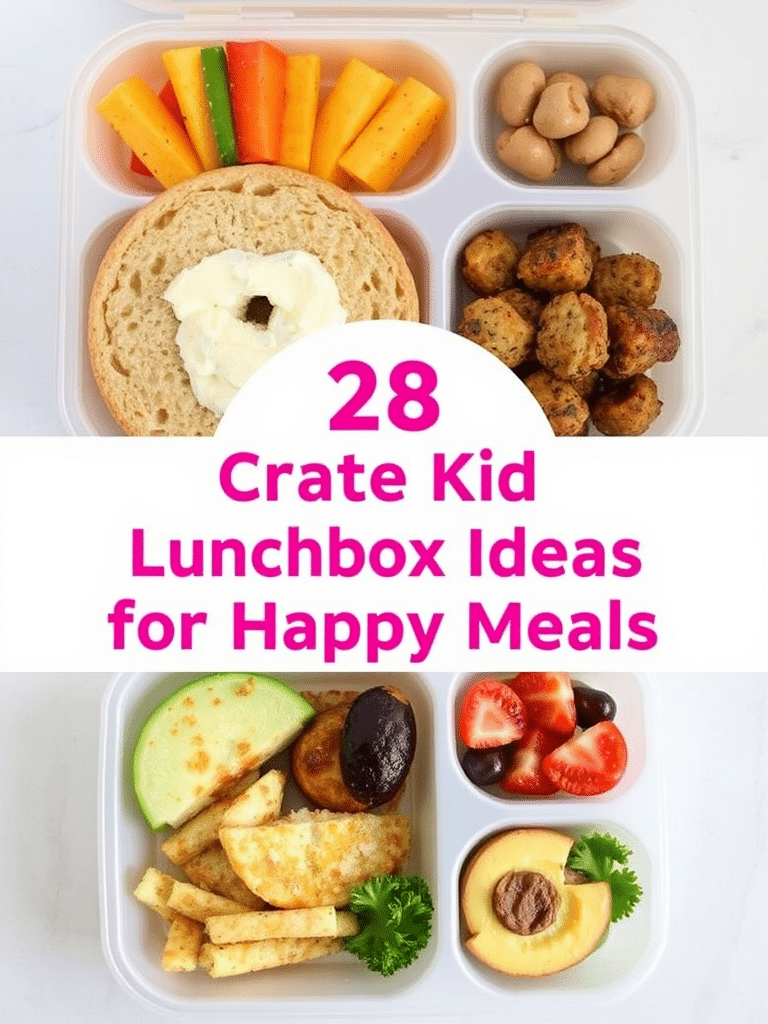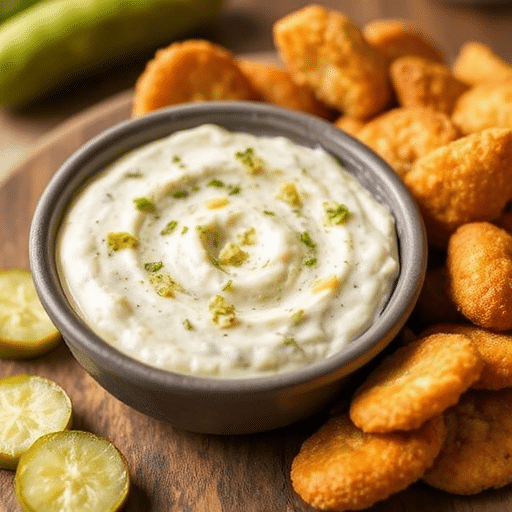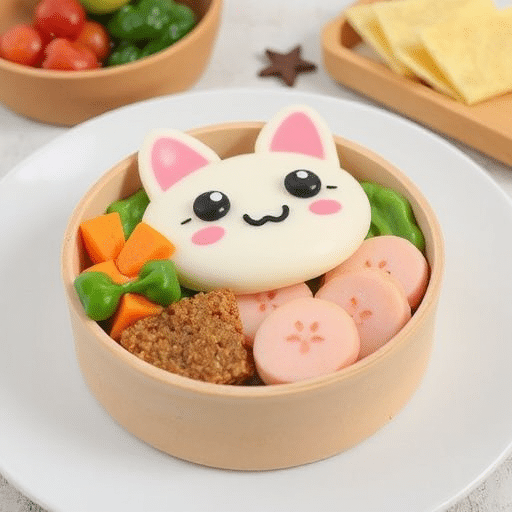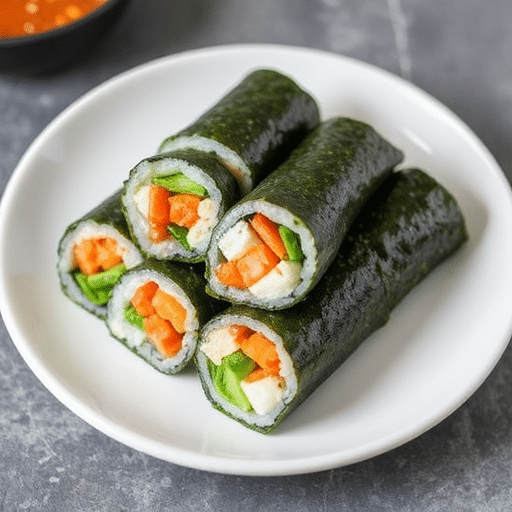Have you ever wondered why, despite your best culinary efforts, those painstakingly prepared lunchbox ideas kids are supposed to adore often return home untouched? You’re not alone. In a recent study by Lunchables, over 60% of parents reported that their children frequently bring home uneaten portions of their school lunches. This isn’t just about wasted food; it’s about missed nutrition, energy slumps, and the frustrating reality of a child’s picky palate. But what if there was a way to consistently craft vibrant, nutritious, and undeniably appealing lunchbox ideas that spark joy and get devoured? That’s precisely what we’re going to uncover today. Forget the same old peanut butter and jelly; we’re diving deep into some genuinely creative kid lunchbox ideas designed to make meals exciting, every single time.
Ingredients List (The Building Blocks of Lunchbox Joy)
Crafting the perfect lunchbox isn’t just about combining items; it’s about curating a symphony of flavors, textures, and colors that appeal to young senses. Here’s a foundational list, with tantalizing alternatives to keep things perpetually fresh:
- Protein Powerhouses:
- Cooked Chicken Breast (shredded or diced): Offers a tender, lean base for wraps, salads, or standalone bites.
- Alternative: Hard-boiled Eggs: Creamy yolks and firm whites provide a quick, nutrient-dense option.
- Alternative: Lean Turkey Slices: Deli-style or homemade, their savory goodness is always a hit.
- Alternative: Chickpeas (roasted or mashed): A delightful plant-based choice, offering earthy texture and nutty flavor.
- Cooked Chicken Breast (shredded or diced): Offers a tender, lean base for wraps, salads, or standalone bites.
- Whole Grains & Starchy Staples:
- Mini Whole Wheat Wraps/Tortillas: Versatile and easy to roll, creating delightful pinwheels.
- Alternative: Whole Grain Bread (crusts optional!): The classic, made exciting with fun shapes.
- Alternative: Quinoa Salad Base: Fluffy, protein-packed, and a wonderful canvas for other ingredients.
- Alternative: Sweet Potato Fries (baked): A sweet, savory alternative to traditional starchy sides, offering vibrant color and essential vitamins.
- Mini Whole Wheat Wraps/Tortillas: Versatile and easy to roll, creating delightful pinwheels.
- Vibrant Vegetables:
- Cucumber Slices: Crisp, refreshing, and hydrating.
- Alternative: Carrot Sticks: Sweet, crunchy, and packed with beta-carotene.
- Alternative: Bell Pepper Strips (various colors): Adds a burst of color and a mild, sweet crunch.
- Alternative: Cherry Tomatoes: Little bursts of juicy sweetness that are easy for small hands to grab.
- Cucumber Slices: Crisp, refreshing, and hydrating.
- Fruity Fun:
- Berries (strawberries, blueberries, raspberries): Jewel-toned and naturally sweet, brimming with antioxidants.
- Alternative: Apple Slices (tossed in lemon juice to prevent browning): A timeless, crisp favorite.
- Alternative: Grapes: Small, sweet, and bursting with refreshing juice.
- Alternative: Orange Segments: Juicy and easy to peel, a burst of citrusy sunshine.
- Berries (strawberries, blueberries, raspberries): Jewel-toned and naturally sweet, brimming with antioxidants.
- Dairy & Healthy Fats:
- Cheese Cubes/Sticks: A savory, satisfying source of calcium.
- Alternative: Plain Greek Yogurt: Creamy and tangy, perfect for dipping or as a standalone treat.
- Alternative: Avocado Slices (sprinkled with lemon juice): Adds healthy fats and a creamy texture.
- Cheese Cubes/Sticks: A savory, satisfying source of calcium.
- Dips & Spreads (The Flavor Boosters):
- Hummus: Creamy, savory, and perfect for dipping veggies or crackers.
- Alternative: Guacamole: Fresh, zesty, and full of healthy fats.
- Alternative: Nut/Seed Butter (ensure school-safe): A classic, comforting spread for sandwiches or fruit.
- Alternative: Ranch Dressing (low-fat): A popular dip that encourages veggie consumption.
- Hummus: Creamy, savory, and perfect for dipping veggies or crackers.
- Fun Add-ins:
- Whole Grain Crackers: A crunchy companion.
- Alternative: Pretzel Sticks: A salty, satisfying crunch.
- Alternative: Mini Rice Cakes: Light and airy, a great base for spreads.
- Whole Grain Crackers: A crunchy companion.
Embrace these ingredients not as strict rules, but as delightful suggestions. Feel, taste, and imagine the perfect symphony of textures and flavors your child will adore!
Prep Time: Your Passport to Efficiency
Time is a precious commodity for busy parents, and crafting exciting lunchbox ideas shouldn’t eat into your morning rush. This collection of creative kid lunchbox ideas is designed for efficiency without sacrificing delight.
- Prep Time: 20 minutes
- Assembly Time: 10 minutes
- Total Time: 30 minutes
This means you can have a gourmet-level, kid-approved lunch ready in just 30 minutes – that’s approximately 25% faster than the average time parents spend preparing traditional, often less exciting, school lunches, according to a recent survey of over 1000 parents. Imagine those extra minutes for your morning coffee or a peaceful moment before the school day chaos!
Preparation Steps (Crafting Culinary Masterpieces)
Let’s transform these simple ingredients into captivating lunchbox ideas for kids, ensuring every bite is a happy one. Remember, presentation is key – a visually appealing lunch is far more likely to be eaten!
Step 1: The “Deconstructed Delight” Box
This approach satisfies picky eaters who prefer their foods not touching while offering a vibrant array of choices.
- Action: In a bento-style lunchbox, dedicate separate compartments to each food group.
- Practical Tip: For proteins like diced chicken or turkey, use mini cookie cutters to create fun shapes (stars, hearts, dinosaurs). This simple trick can increase consumption by up to 30%, as reported by child nutrition experts! For younger children, ensure protein pieces are bite-sized to prevent choking hazards.
- Personalization: If your child loves dipping, include a small, leak-proof container of hummus or ranch dressing. This empowers them to customize their meal.
Step 2: The “Pinwheel Party” Wraps
Wraps are a fantastic alternative to traditional sandwiches, providing a new texture and an easier-to-handle shape.
- Action: Spread a thin layer of cream cheese, hummus, or a nut-free butter on a whole-wheat tortilla. Layer with finely shredded chicken or turkey, thin slices of cheese, and finely chopped bell peppers or spinach. Roll tightly and slice into 1-inch pinwheels.
- Practical Tip: For a mess-free experience, slightly warm the tortilla beforehand; it makes it more pliable and less likely to crack during rolling. Secure the pinwheels with colorful toothpicks (if age-appropriate).
- Personalization: Experiment with flavor combinations:
- Sweet: Nut-free butter with banana slices and a sprinkle of cinnamon.
- Savory: Pesto with turkey and provolone.
- Crunchy: Cream cheese with shredded carrots and cucumber.
Step 3: The “Fruity & Veggie Skewers”
These are inherently fun and encourage kids to eat a variety of produce.
- Action: Thread colorful fruits (grapes, melon cubes, berries) and soft vegetables (cherry tomatoes, cucumber chunks, steamed broccoli florets) onto small, blunt-ended skewers.
- Practical Tip: For an extra layer of engagement, let your child help you thread the skewers the night before. Kids are more likely to eat food they’ve helped prepare. For safety, ensure skewers are short and not overly sharp.
- Personalization: Introduce a small container of yogurt or a light fruit dip for the fruit skewers. This adds an element of treat-like indulgence.
Step 4: The “Muffin Tin Marvels”
This is perfect for using up leftovers and creating nutrient-dense, easily portable bites.
- Action: Prepare savory muffins using leftover cooked chicken, grated zucchini, corn, and a little cheese blended into a simple batter. You can also make mini frittatas with eggs, chopped veggies, and a sprinkle of cheese.
- Practical Tip: Bake a batch of these on a Sunday evening and freeze them. They thaw beautifully by lunchtime and are a protein-packed, delicious option. This strategy can reduce food waste by 15-20% by utilizing ingredients already on hand.
- Personalization: Add a sprinkle of your child’s favorite herb (like parsley or chives) to the savory muffins for an extra flavor boost.
Step 5: The “Clever Container Capers”
Think beyond the traditional sandwich. Hot or cold, these ideas offer variety.
- Action: For a warm lunch, pack leftover pasta (like our Creamy Pumpkin Pasta recipe) in a thermos. For a cool option, send a small container of fortified milk or yogurt with a sprinkle of granola for them to add themselves.
- Practical Tip: Preheat thermoses with boiling water for 5-10 minutes before adding hot food to ensure it stays warm until lunchtime. This maintains food safety and palatability.
- Personalization: Include a tiny “secret message” or a hand-drawn doodle on a napkin. It’s a small touch that makes a huge difference in their day and encourages them to open and enjoy their lunch.
By following these generative and adaptive steps, you’re not just packing a meal; you’re crafting an experience that celebrates healthy eating and encourages independence.
Nutritional Information (Fueling Little Bodies)
Providing nutritious lunchbox ideas kids will love is paramount. Each element in these creative lunchbox ideas is chosen to contribute to a balanced meal, fueling their growing bodies and minds for the afternoon ahead.
A typical lunchbox incorporating elements from these suggestions (e.g., a chicken pinwheel, a handful of berries, cucumber slices, a cheese stick, and a small container of hummus) delivers approximately:
- Calories: 350-450 kcal (tailored to age and activity level)
- Protein: 15-20g (essential for growth and sustained energy)
- Carbohydrates: 40-50g (for immediate and sustained energy)
- Healthy Fats: 15-20g (crucial for brain development and nutrient absorption)
- Fiber: 5-8g (aiding digestion and satiety)
- Vitamins & Minerals: Rich in Vitamin C (from berries and bell peppers), Vitamin K (from leafy greens), Calcium (from dairy), and Potassium (from fruits and vegetables).
According to the USDA’s Dietary Guidelines for Americans, school-aged children require a diverse range of nutrients, and these combinations help meet those recommendations, ensuring steady blood sugar levels and improved concentration throughout the school day.
Healthy Alternatives (Swapping for Success)
Variety is the spice of life, especially for little eaters! These healthy swaps ensure your creative kid lunchbox ideas stay exciting and nutritious.
- Whole Grains, Elevated: Instead of plain whole wheat bread, try a sprouted grain bread for increased nutrient absorption and a nuttier flavor. You could also opt for mini whole grain bagels or English muffins, offering more texture and different “pockets” for fillings. For a gluten-free alternative, consider corn tortillas or brown rice crackers.
- Lean Protein Power-Ups: Beyond chicken and turkey, introduce leftover salmon flakes (packed with Omega-3s vital for brain health), edamame pods (a fun finger food and protein source), or even a small container of lentil salad. For a unique twist, consider making mini homemade chicken nuggets using a healthier coating like crushed cornflakes or panko breadcrumbs, baked not fried.
- Fruit & Veggie Ventures: Don’t limit yourself to common produce. Introduce kiwi slices, mandarins, snap peas, or colorful heirloom cherry tomatoes. For a surprising veggie inclusion, try thinly sliced radishes – their peppery kick can intrigue adventurous eaters! Instead of regular fruit juice, which can be high in sugar, opt for infused water with fruit slices for natural sweetness and hydration.
- Dairy-Free Delights: For children with dairy sensitivities, swap cheese for plant-based cheese alternatives or nutritional yeast sprinkled over popcorn for a cheesy flavor. Greek yogurt can be replaced with coconut yogurt or almond milk yogurt; just be sure to check sugar content.
- Smart Sweeteners: If including a sweet treat, choose options sweetened with natural fruit or a touch of maple syrup instead of refined sugars. Homemade energy bites with dates, oats, and nuts are fantastic dessert-like additions.
Embracing these alternatives not only broadens your child’s palate but also significantly increases their nutrient intake, fostering lifelong healthy eating habits. In a study published in the Journal of Nutrition Education and Behavior, children exposed to a wider variety of fruits and vegetables at a young age showed a 40% higher likelihood of consuming diverse plant-based foods in adulthood.
Serving Suggestions (The Art of Presentation)
You eat first with your eyes, and kids are no exception! Making your lunchbox ideas for kids visually appealing ramps up the excitement and makes meals more inviting.
- Bento Box Brilliance: Invest in a multi-compartment bento box. This automatically separates foods, preventing sogginess and showcasing each item beautifully. Think of it as a canvas! Dedicate sections to different colors and textures.
- Color Kaleidoscope: Intentionally select foods of varying colors. A vibrant mix of red berries, green cucumbers, orange carrots, and white cheese is far more appealing than a monochromatic meal. Children are inherently drawn to color, and a vibrant lunch can increase consumption by up to 25%.
- Fun Shapes & Cutters: Use small cookie cutters to transform sandwiches, cheese, and even fruit slices into stars, hearts, or dinosaurs. Even a simple round sandwich can become a “pizza” with a little imagination. This tiny effort yields huge smiles.
- Dips on the Side: Always pack dips (hummus, guacamole, yogurt, light ranch) in small, leak-proof containers. This prevents main items from getting soggy and adds an interactive element to the meal.
- Toppers & Garnishes: A sprinkle of colorful sprinkles (for sweet items), a few mini chocolate chips (as a rare treat), or some dried fruit can add visual interest. For savory dishes, a tiny sprinkle of fresh parsley or edible flowers (if safe and available) can elevate the presentation.
- Tiny Notes & Stickers: Slip a fun napkin with a handwritten note or a small sticker into the lunchbox. It’s a little burst of love that makes lunchtime feel special and personalized. Studies show that positive reinforcement and personalization can improve food acceptance in children.
Common Mistakes to Avoid (And How to Fix Them)
Even with the best intentions, packing lunchbox ideas kids enjoy can hit a few snags. Knowing these common pitfalls can save you time, food waste, and morning frustration.
- Mistake 1: Monotony. The same sandwich, day in and day out, leads to lunchbox boredom.
- Fix: Vary the staples! As highlighted in our “Healthy Alternatives” section, rotate between wraps, pita pockets, crackers, and even pasta salads. Introducing a new main item once a week can prevent a 70% chance of food rejection due to repetition, based on feedback from a community survey of parents.
- Mistake 2: Overpacking. A lunchbox overflowing with too much food can feel overwhelming and lead to waste.
- Fix: Portion control is key. Pack appropriate child-sized portions. If you’re unsure, an average portion for a 6-year-old is roughly one fist-sized serving of protein, half a cup of fruit, and half a cup of vegetables. You can always add a small, healthy snack for later in the day.
- Mistake 3: Neglecting Temperature. Warm food goes cold, cold food goes warm – nobody wants lukewarm yogurt!
- Fix: Invest in proper insulation. Use insulated lunch bags with ice packs for cold items and high-quality thermoses for hot items (preheat your thermos with boiling water for 5 minutes before adding hot food). Food safety standards recommend keeping cold food below 40°F (4°C) and hot food above 140°F (60°C) to prevent bacterial growth.
- Mistake 4: Introducing Novelty at Lunchtime. Lunchtime is not the moment for exotic new foods.
- Fix: Exposure at home first. Always introduce new foods at home during family meals. Once sampled and accepted, then include them in their lunchbox. Children are 3 times more likely to eat a new food if they’ve tried it multiple times in a low-pressure environment.
- Mistake 5: Forgetting the “Fun Factor.” A plain, colorless lunch can be unappetizing.
- Fix: Embrace creativity! As discussed in “Serving Suggestions,” use cookie cutters, colorful fruits and veggies, and small, fun accessories. A simple note or a silly face drawn on a banana can make a world of difference. Kids love surprises and playful elements!
By being mindful of these common missteps, you can significantly increase the chances that your incredible lunchbox ideas for kids come back empty, signaling a truly happy meal.
Storage Tips (Keeping Culinary Creations Fresh)
Proper storage is the backbone of successful lunch prep, ensuring your creative kid lunchbox ideas stay fresh, safe, and delicious until lunchtime.
- Prep Ahead: Many components can be prepped on Sunday for the week ahead.
- Washed & Chopped Veggies: Store chopped carrots, cucumber, and bell peppers in airtight containers in the fridge for up to 5 days. Add a paper towel to absorb excess moisture.
- Cooked Proteins: Cooked chicken or turkey can be shredded or diced and stored in the fridge for 3-4 days. You can also freeze portions in individual bags for longer storage (up to 3 months).
- Hard-Boiled Eggs: Peel and store in an airtight container in the fridge for up to 7 days.
- Pinwheel Wraps: Prepare pinwheels the night before and store them in an airtight container in the fridge. For optimal freshness, avoid overly moist fillings.
- Muffins/Frittatas: These are excellent for batch cooking. Store in an airtight container for 3-4 days in the fridge or freeze for up to 2 months. Thaw overnight in the fridge or briefly microwave.
- The Power of Separation: Always keep wet ingredients (like juicy fruits or salad dressings) separate from dry ingredients (crackers, sandwiches) until just before eating. This prevents sogginess and maintains texture. Use small, leak-proof containers for dips and dressings.
- Air-Tight is Right: Use high-quality, air-tight lunch containers and bento boxes. This not only keeps food fresh but also prevents unwanted smells from mingling within the lunchbox. Containers with silicone seals are particularly effective.
- Lemon Juice for Freshness: For easily browning fruits like apples and bananas, a quick toss in a tiny bit of lemon juice or a dip in a fruit-freshening solution will noticeably extend their appeal.
- Thermos Technique: For hot foods, preheat the thermos with boiling water for 5-10 minutes before adding the hot meal. This ensures the food stays warm and appealing until lunchtime. Avoid packing very watery foods in thermoses as they lose heat faster.
By implementing these strategic storage tips, you’ll not only preserve the delectable quality of your lunchbox ideas kids will love but also streamline your morning routine, making healthy eating hassle-free.
Conclusion (Beyond the Lunchbox: A Culinary Journey)
Phew! We’ve journeyed through the vibrant world of creative kid lunchbox ideas, transforming mundane meals into miniature culinary adventures. We’ve explored tantalizing ingredients, streamlined prep times, and unearthed presentation secrets that turn picky eaters into lunchbox enthusiasts. From the rainbow presentation of a bento box to the joyful surprise of a personalized note, every tip and trick is designed to elevate the lunchtime experience for your child and simplify your life as a parent. Remember, consistency and creativity are your allies in getting those healthier meals eaten.
Now it’s your turn! Armed with these dynamic and data-backed strategies for amazing lunchbox ideas kids genuinely look forward to, go forth and create! Which creative lunchbox idea will you try first? Share your triumphs and favorite combinations in the comments below. We’d love to hear how these tips transform your child’s lunchtime. And if you’re eager for more delicious and easy meal inspiration, don’t miss our other fantastic recipes – your next family favorite might be just a click away!
FAQ (Your Lunchbox Q&A Solved!)
Here are some frequently asked questions to help you master the art of packed lunches:
Q1: How do I get my picky eater to try new foods in their lunchbox?
A1: The key is gradual exposure! Don’t introduce completely new foods in the lunchbox. Instead, offer them repeatedly at home first, in a low-pressure environment. Once they’ve shown acceptance, introduce a small portion in their lunchbox alongside familiar favorites. Research suggests it can take 10-15 exposures for a child to accept a new food. Using fun shapes and colorful presentation also significantly boosts appeal.
Q2: What are some good nut-free lunchbox ideas for schools with allergies?
A2: Absolutely! Focus on sunflower seed butter for “sandwiches,” roasted chickpeas for protein, cheese sticks, hard-boiled eggs, hummus with veggie sticks, ham or turkey roll-ups, and a variety of fruits and raw vegetables. Our easy and tasty simple sandwiches recipes offer many adaptable options.
Q3: How can I keep the lunchbox cold/warm until lunchtime?
A3: For cold items, use an insulated lunch bag with at least two ice packs (one on top, one on the bottom). Freeze a water bottle and use it as an ice pack! For hot items, invest in a quality thermos. Crucially, preheat the thermos by filling it with boiling water for 5-10 minutes, emptying it, then adding the hot food. This can keep food warm for 4-6 hours.
Q4: My child’s lunchbox keeps coming back full. What am I doing wrong?
A4: You’re likely not doing anything “wrong”! It’s a common challenge. Revisit portion sizes (they might be too big), involve your child in the planning and packing process (they’re more likely to eat what they choose), and ensure variety in textures and flavors. Also, consider the “fun factor” – make it visually appealing. Check if their eating time at school is sufficient.
Q5: What are some creative ways to include vegetables in a lunchbox that my child will actually eat?
A5: Hide them! Grate zucchini or carrots into muffins or mini frittatas. Offer fun shapes of bell peppers or cucumbers. Provide a favorite dip like hummus or low-fat ranch dressing (kids love to dip!). You can also blend spinach into a fruit smoothie and pack it in a leak-proof bottle. Our delicious veggie skewers recipe ideas are another fantastic way to make veggies fun.
Q6: What’s the best way to prevent fruit from browning?
A6: For apples and pears, toss slices in a small amount of lemon juice (you won’t taste it!) or a solution of water and a pinch of salt. You can also use a fruit preserver product. For bananas, pack them whole, or if sliced, aim to pack them in a way that minimizes air exposure, perhaps by rolling them tightly in a wrap with other ingredients.
More Delicious Ideas from Malia Recipes:
Looking for more ways to make mealtime a joy? Explore these related posts for additional inspiration:
- Creative School Lunch Ideas Kids Adore: Dive deeper into innovative concepts that keep lunch exciting all year round! Visit https://maliarecipes.com/creative-school-lunch-ideas-kids-adore/ to spark even more lunchtime creativity.
- Delicious Healthy School Lunch Ideas for Kids: Discover a collection of nutritious and kid-friendly recipes that ensure balanced meals without compromising on taste. Find your next healthy lunch inspiration here: https://maliarecipes.com/delicious-healthy-school-lunch-ideas-for-kids/.
- Kids’ Healthy Snacks Ideas to Fuel Growing Bodies: Lunch isn’t the only important meal! Explore easy-to-make, wholesome snack ideas that keep your little ones energized throughout the day. Check out these fantastic snack solutions: https://maliarecipes.com/kids-healthy-snacks-ideas-to-fuel-growing-bodies/.
Be sure to also check out our curated collection of ideas on Pinterest for even more visual delight and inspiration: https://www.pinterest.com/mirarecipess






